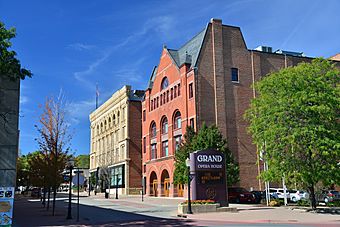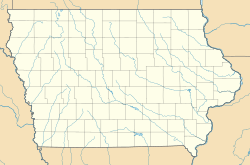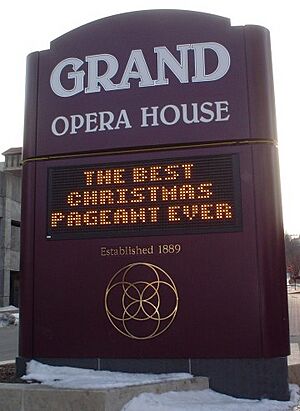Grand Opera House (Dubuque, Iowa) facts for kids
Quick facts for kids |
|
|
Grand Opera House
|
|
 |
|
| Location | 135 8th St. Dubuque, Iowa |
|---|---|
| Area | less than 1 acre (0.40 ha) |
| Built | 1890 |
| Architect | Willoughby J. Edbrooke |
| Architectural style | Richardsonian Romanesque |
| MPS | Footlights in Farm Country: Iowa Opera Houses MPS |
| NRHP reference No. | 02001029 |
| Added to NRHP | September 20, 2002 |
The Grand Opera House is a famous old theater in Dubuque, Iowa. It was built way back in 1890. This special building is located at 8th and Iowa Streets. In 2002, it was added to the National Register of Historic Places. This means it is a very important historical site.
The Grand Opera House is considered a "national treasure." It has the biggest stage ever built in Dubuque. It is also the only old opera house still standing in the city. The building's design is very important. It shows an early example of the Richardsonian Romanesque style. This style uses strong, simple shapes and rough stone.
A famous architect named Willoughby James Edbrooke designed the Grand Opera House. This is the only opera house he designed that is still around. He even used its design to help him get a big job in 1891. He became the Supervising Architect for the U.S. Treasury Department. The theater's design shows Edbrooke's smooth style of Richardsonian Romanesque.
The Grand Opera House is also important because of the amazing shows it hosted. Many high-quality plays and performances took place there from 1890 to 1928. The theater has been kept in great shape. In 2002, it was being fixed up so people could keep enjoying live shows there. Its long history is very well known. In 2015, the theater celebrated its 125th birthday with special performances.
Contents
History of the Grand Opera House
Building the Theater
The Grand Opera House was built between 1889 and 1890. A group of people, including William Lester Bradley, Sr., started a company in 1890. This company, called The Grand Opera House, Inc., ran this theater and others in Dubuque. Building the opera house cost about $65,000.
When it was finished, the Grand Opera House was the biggest theater in Dubuque. It could seat 1,100 people. The stage was huge, measuring 42 feet from the front to the back. At first, there was even a tunnel connecting the opera house to a house next door. Performers used this house to change into their costumes.
Opening Night and Early Shows
The first show was supposed to be on August 15, 1890. But that day was a special religious holiday. So, the opening night was moved to August 14. About 800 people paid five dollars to see the show. The Hess Opera Company performed "Carmen," a famous French opera by Georges Bizet.
For the next 40 years, over 2,600 live shows were performed at the Grand. Many famous actors and performers appeared on its stage. These included Henry Fonda, Ethel Barrymore, George Cohan, Sarah Bernhardt, and Lillian Russell. Years later, Henry Fonda remembered his time at the Grand fondly. He was happy that the theater was still standing.
One of the most amazing shows was "Ben-Hur." This play even had real horses and chariots on stage! The theater made a profit for 22 of its first 28 years. The six years it didn't make money were because of big improvements made to the building.
The Movie Era
In 1915, movies were shown at the Grand for the first time. That first year, the theater made $15,488 in profit from movies. This was three times more than what it made from traditional plays. In 1928, the Grand had its last live performance for many years. It was a play called "The Merry Wives of Windsor."
In 1930, the Grand was changed into a movie theater. The second balcony and special box seats were removed. The orchestra pit, where musicians played, was covered up. The curved stage was made straight. A big screen and a new projector were added for showing films.
When the Grand became a movie theater, most movie theaters were in downtown Dubuque. By 1972, the Grand was the only downtown movie theater left. It was sold to Richard Davis of Des Moines. In 1976, Davis sold it to the Dubinsky Brothers. The Grand continued to show movies for several more years.
Live Theater Returns
By the late 1900s, a group called the Barn Community Theater bought the Grand Opera House. It was empty and needed a lot of repairs. This marked the end of the Grand's time as a movie theater. In 1986, a play called "Tintypes" was performed there. This was the first live show at the Grand in over 57 years!
In recent years, the Grand Opera House has been fixed up many times. The outside of the building was restored to its original look. This meant taking off a big sign and metal covering that were added in the 1960s. The inside of the theater was also renovated and made beautiful again.




